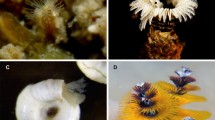Abstract
The ultrastructure of the genera Althornia, Aplanochytrium, Japonochytrium, Schizochytrium and Thraustochytrium is described, and all are regarded as members of the new order Thraustochytriales Sparrow. Species considered are Althornia crouchii, Aplanochytrium kerguelensis, Hyalochlorella marina, Japonochytrium sp., Schizochytrium aggregatum, Thraustochytrium kinnei and T. striatum. All but H. marina are, on ultrastructural evidence, related genera, and some speculative suggestions are made about possible interrelationships both between the species discussed, between the Thraustochytriales and Labyrinthulales, and between these two and other major taxa.
Similar content being viewed by others
Literature Cited
Alderman, D. J.: Ultrastructure of Hyalochlorella marina. Veröff. Inst. Meeresforsh., Bremerh. (1974). (In press).
Bahnweg, G. and F. K. Sparrow, Jr.: Aplanocytrium kerguelensis gen. nov. spec. nov. A new phycomycete from subantarctic marine waters. Arch. Mikrobiol. 81, 45–49 (1972).
Bahnweg, G. and F. K. Sparrow, Jr.: Four new species of Thraustochytrium from Antarctic regions, with notes on the distribution of zoosporic fungi in the Antarctic marine ecosystems. Am. J. Bot. (1974). (In press).
Booth, T. and C. E. Miller: Comparative morphologic and taxonomic studies in the genus Thraustochytrium. Mycologia 60, 480–495 (1968).
Darley, W. M., D. Porter and M. S. Fuller: Cell wall composition and synthesis via golgi-directed scale formation in the marine eucaryote, Schizochytrium aggregatum with a note on Thraustochytrium sp. Arch. Mikrobiol. 90, 89–106 (1973).
Fuller, M. S., B. E. Fowles and D. J. McLaughlin: Isolation and pure culture study of marine phycomycetes. Mycologia 56, 745–756 (1964).
Goldstein, S.: Development and nutrition of new species of Thraustochytrium. Am. J. Bot. 50, 271–279 (1963).
— and L. Moriber: Biology of a problematic marine fungus. Dermocystidium sp. 1. Development and cytology. Arch. Mikrobiol. 53, 1–11 (1966).
Harrison, J. L.: The salinity tolerances of freshwater and marine zoosporic fungi, including some aspects of the ecology and ultrastructure of the Thraustochytriaceae. Ph. D. Thesis, University of London 1972.
Hibber, D. J. and G. F. Leedale: Eustigmatophyceae—a new algal class with unique organisation of the motile cell. Nature, Lond. 225, 758–760 (1970).
Johnson, T. W. and F. K. Sparrow, Jr. (Eds): Fungi in oceans and estuaries, 688 pp. Weinheim: J. Cramer 1961.
Jones, E. B. G. and D. J. Alderman: Althornia crouchii gen. et. sp. nov., a marine biflagellate fungus. Nova Hedwigia 21, 381–387 (1971).
Jones, E. B. G., J. L. Harrison, G. B. Bremer and D. J. Alderman: Some problems in the taxonomy of marine biflagellate fungi. Proceedings of the International Symposium on Fungal Taxonomy, 1973, Madras, India. (In press).
Kobayashi, Y. and M. Ookubo: Studies on the marine phycomycetes (I). Bull. natn. Sci. Mus., Tokyo 33, 53–65 (1953).
Mackin, J. G. and S. M. Ray: The taxonomic relationships of Dermocystidium marinum Mackin, Owen and Collier. J. Invertebr. Path. 8, 544–545 (1966).
Mandon, I.: Some possibly significant structural relations between chloroplasts and other cell components. In: Biochemistry of chloroplasts, Vol. 1. pp 23–47. Ed. by T. W. Goodwin. New York & London: Academic Press 1966.
Perkins, F. O.: Ultrastructure of vegetative stages in Labyrinthomyxa marina (=Dermocystidium marinum), a commercially significant oyster pathogen. J. Invertebr. Path. 13, 199–222 (1969).
—: The ultrastructure of holdfasts, “rhizoids” and “slime tracks” in Thraustochytriaceous fungi and Labyrinthula spp. Arch. Mikrobiol. 84, 95–118 (1972).
—: A new species of marine labyrinthulid, Labyrinthuloides yorkensis gen. nov. spec. nov. Cytology and fine structure. Arch. Mikrobiol. 90, 1–17 (1973a).
—: Observations on thraustochytriaceous (phycomycetes) and labyrinthulid (Rhizopodea) ectoplasmic nets on natural and artificial substrates—an electron microscope study. Can. J. Bot. 51, 485–491 (1973b).
Porter, D.: The ultrastructure of Labyrinthula. Protoplasma 67, 1–19 (1969).
—: Cell division in the marine slime mold, Labyrinthula sp. and the role of the bothrosome in extracellular membrane production. Protoplasma 74, 427–448 (1972).
Poyton, R. O.: The characterisation of Hyaloclorella marina gen. et sp. nov. a new colourless counterpart of Chlorella. J. gen. Microbiol. 62, 171–188 (1970).
Reynolds, E. S.: The use of lead citrate at high pH as an electron opaque stain in electron microscopy. J. Cell Biol. 17, 208–212 (1963).
Sparrow, F. K.: Remarks on the Thraustochytriacea. Veröff. Inst. Meeresforsch., Bremerh. 11, 7–18 (1968).
—: Mastigomycotina. In: The fungi,Vol. 4B. pp 61–73. Ed. by G. C. Ainsworth, F. K. Sparrow, and A. S. Sussman. New York: Academic Press 1974.
Author information
Authors and Affiliations
Additional information
Communicated by J. H. S. Blaxter, Oban
Rights and permissions
About this article
Cite this article
Alderman, D.J., Harrison, J.L., Bremer, G.B. et al. Taxonomic revisions in the marine biflagellate fungi: The ultrastructural evidence. Mar. Biol. 25, 345–357 (1974). https://doi.org/10.1007/BF00404978
Accepted:
Issue Date:
DOI: https://doi.org/10.1007/BF00404978




